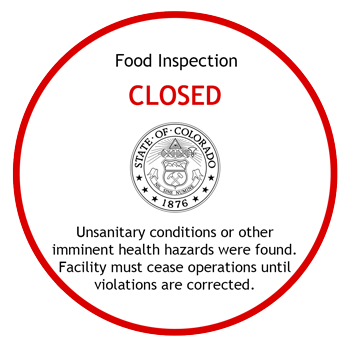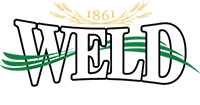Restaurant Inspections are moving to HealthSpace
Weld County Restaurant Inspections after October 16, 2023 can be found on HealthSpace portal.

RETAIL FOOD ESTABLISHMENT INSPECTION REPORT
| Facility Name: | CACCIATORE HELLERS KITCHEN |
| Address: | 301 MAIN STREEET WINDSOR, CO 80550 |
| Phone: | (970) 690-7748 |
| Inspection Date: | June 28, 2023 |
| Owner: | TROY HELLER |
| Inspection Type: | REGULAR INSPECTION |
| Yelp: | Check Now |
| POINTS | VIOLATION | VIOLATION ID |
|---|---|---|
|
25 pts.
|
No bare hand contact with RTE food or a pre-approved alternative procedure properly allowed
Comment: (Corrected) Observed olives and oranges placed in drinks at the bar with bare hands. Observed kitchen employee plating toppings onto foods ready for service with bare hands. Bare hand contact with ready-to-eat food is prohibited. Use of gloves, tissue paper, tongs or other adequate utensil is required. Corrected by discussing with staff and observing use of gloves or utensils. | 09 |
|
20 pts.
|
Food in good condition, safe, & unadulterated
Comment: (Corrected) Found fully thawed tuna in vacuum packaging in the walk-in cooler. Employee stated tuna was placed in cooler 4 days prior. Food shall be in sound condition, free of spoilage or contamination and shall be safe for human consumption. Fish in reduced oxygen packaging, or in packaging that states "keep frozen" or "remove from package to thaw" shall be removed from the package before thawing. Found an open bag of tuna on top of an open package of proscuitto with visible fluid contamination. Cross-contamination of raw to ready-to-eat food shall be prevented at all times. Corrected by discarding meat. Mold observed on tomatoes and one bell pepper in the rear walk-in cooler. Food shall be in sound condition, free of spoilage or contamination and shall be safe for human consumption. Corrected by discarding affected produce. | 13 |
|
20 pts.
|
Food contact surfaces; cleaned & sanitized
Comment: (Corrected) Observed heavily soiled food probe thermometer in use. When employee was asked about cleaning practices employee stated thermometer is only wiped with sanitizer and not washed. All food contact surfaces shall be maintained clean and sanitary. Equipment that is used continuously shall be washed, rinsed and sanitized in an approved sanitizer concentration every 4 hours. Corrected by running through dish machine. Employee cell phone was stored on cutting board where food was being prepared. Sanitizer bucket stored on floor was picked up and placed on food preparation table. All food contact surfaces shall be maintained clean and sanitary. Corrected by moving cell phone and replacing cutting board, and storing sanitizer bucket off the floor and cleaning the prep table. | 16 |
|
20 pts.
|
Proper hot holding temperatures
Comment: (Corrected) Found two cheese based sauces improperly hot holding in steam wells (101 and 122 F). Both sauces were double panned with no water in the larger pan. Foods requiring temperature control shall be held hot at 135 F or above. Sauces had been stocked for approximately 2 hours. Corrected by reheating to 165 F and adding water to pan for proper hot holding. | 21 |
|
20 pts.
|
Proper cold holding temperatures
Comment: (Corrected) Found cooked portioned bags of two types of pastas above the fill line in the top of the line cooler at 55 F. Found a squeeze bag of ricotta cheese stored on top of pans in the cooler across the pizza oven with temperatures between 44-50 F. Cooked garlic in oil was stored on shelf at ambient temperature with garlic measuring 70 F. Foods requiring temperature control shall be kept cold at 41 F or below. Per employees, all items had been out since opening today which was less than 2 hours prior. Corrected by moving all items to bottom of line coolers or walk-in cooler. | 22 |
|
15 pts.
|
Person in charge present, demonstrates knowledge, and performs duties
Comment: Based on the number of risk factor violations and repeating history of violations, employees were unable to demonstrate knowledge of food safety practices to the inspector. Staff shall obtain training in food safety practices within 10 days. | 01 |
|
10 pts.
|
Required records available: shellstock tags, parasite destruction
Comment: Facility does not have shellstock tags for raw oysters for the last 90 days. One bag of recent tags is available but missing date of last use on most tags. Shellstock tags shall be marked with the date of last use and maintained in chronological order for at least 90 days. Correct immediately. | 14 |
|
5 pts.
|
Proper cooking time & temperatures
Comment: (Corrected) Found par-cooked salmon with no label to indicate it as a raw product. Par-cooking procedures shall include labeling as raw. Corrected by labeling. | 18 |
|
5 pts.
|
Proper date marking and disposition
Comment: (Corrected) Found a pan of chicken cooked the day prior with no date marked. Found portioned bags of cooked vegetable mix in bottom of line cooler dates 6/13-6/19. Ready to eat foods requiring temperature control that are held for more than 24 hours shall be labeled with the date prepared or opened, and shall be held for a maximum of 7 days or by manufacturer use-by date, whichever occurs first. Corrected by dating chicken and discarding vegetable mix. | 23 |
Inspection Background
The mission of the retail food inspection program is to prevent food-borne disease (or food poisoning, as it's sometimes called).
The Internet allows us to share inspection information which may help you to make your food purchasing decisions. Reading the inspection
report only, without knowing about the different types of violations, may still lead you to the wrong conclusion about what is safe and what is unsafe.
So, please take a few minutes to familiarize yourself with the inspection process and violation types before reading the inspection reports.
View Sample inspection
Inspection Frequency:
Retail food establishments include restaurants, grocery stores, convenience stores, bars, schools, bakeries and more. Inspections are scheduled one to three times per year, depending on the size of the menu, number of people served each day, the cooking processes used, whether or not the establishment has had a foodborne illness outbreak or is in extended enforcement action, or serves a population at higher risk of acquiring a foodborne illness.
Violations:
Core item means a provision in this Code that is not designated as a priority item or a priority foundation and usually relates to general sanitation, operational controls, sanitation standard operating procedures (SSOPs), facilities or structures, equipment design, or general maintenance.
Priority foundation item includes an item that requires the purposeful incorporation of specific actions, equipment or procedures by industry management to attain control of risk factors that contribute to foodborne illness or injury such as personnel training, infrastructure or necessary equipment, HACCP plans, documentation or record keeping, and labeling;
Priority item means a provision in this Code whose application contributes directly to the elimination, prevention or reduction to an acceptable level, hazards associated with foodborne illness or injury and there is no other provision that more directly controls the hazard and includes items with a quantifiable measure to show control of hazards such as cooking, reheating, cooling, handwashing.
Retail food establishments operate under the Colorado Retail Food Establishment Rules and Regulations. An inspection report is a "snapshot" of the day and time of the inspection. On any given day, the establishment could have fewer or more violations than noted in the report you are viewing. A single inspection may not represent the long-term performance or safety of the business. Also, all violations are recorded during the inspection but as many as possible are corrected before the inspector leaves. Regulatory re-inspections or "follow-ups" are done as necessary.
Retail Food Establishment Scoring
Risk Index Values of Inspection Violations
Restaurants and other retail food establishments are scored using a risk index system. With a risk index system, as when playing golf, the lower the final number, the better. Violations are more heavily weighted when they pose a greater risk to the safe preparation of food. For example, not cooking chicken to the required temperature would pose a greater risk to a consumer's health than a kitchen floor in disrepair. Point values for violations range from 0-25 points.
|
Pass - Pass means the establishment meets fundamental food safety standards. The establishment could have some priority, priority foundation or core violations. Some or all violations were corrected during inspection. The risk index range is 0-49 total points.
Re-Inspection - Re-Inspection means that food safety violations were found. Corrections may have been made but the rating requires a re-inspection to ensure basic food safety standards are met. The establishment has a higher level of risk with several priority, priority foundation or core violations. The risk index range is 50-109 total points.
Closed - Closed means that significant unsanitary conditions or other imminent health hazards were found. The establishment has multiple priority, priority foundation or core violations representing high risk. Facility must cease operations until conditions and violations are corrected. Facility must receive prior approval by the health authority before reinitiating operations. The risk index range is 110 total points or higher.
Inspection Types
Regular Inspection - Routine, unannounced, nonscheduled inspections. Facilities are inspected between 1-4 times per year based on complexity of operation, population served, and previous food safety performance.
Re-Inspection - Unannounced, nonscheduled inspection within 10 business days after a non-passing inspection (above 50 points).
Closure - Imminent public health hazard present requiring the facility to be closed including: no water, sewage backup, pest infestation, or long-term non-compliance to food safety rules.
Conditions Met to Re-open - Facility has corrected imminent public health hazard conditions and has been reviewed by health department to safely produce food.
Check-in - Quick visit by health department to evaluate or discuss a key item. This may be requested by the facility or based on inspector evaluation of the facility.
Announced Inspection - Scheduled inspection requested by the establishment.
Targeted Training - Scheduled training inspection regarding specific food safety items. For example, proper cooling demonstration for all food handlers.
New Facility Check Up - Nonregulatory inspector "meet and greet" immediately after opening to discuss procedures, answer questions, and ensure food safety compliance.
Retail Food Inspection Search
Some hints for a successful search:
- If you can only remember part of the establishment’s name, try entering the first few letters. Entering part of a name will return all establishments that have names beginning with those letters.
- You can also select a city name together with establishment name.
